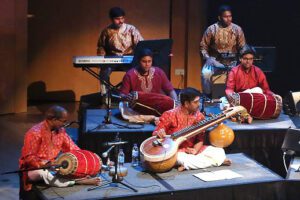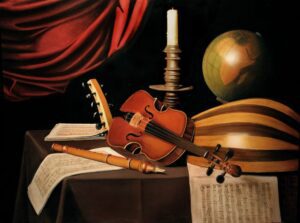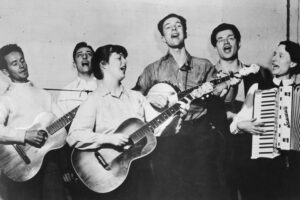Indian Music
Indian music encompasses a wide range of styles, from folk traditions like Bhangra and Rajasthani to classical genres like Hindustani and Carnatic. Bollywood music is a synthesis of different styles, whereas devotional music such as Qawwalis and Bhajans evokes spirituality. India’s cultural diversity is reflected in the variety of instruments, rhythms, and melodies found in each region.

Karnataka music
The Karnataka branch acts out the Indian music that is composed in the traditional octave, the music is Kriti-based and lays more emphasis on the quality of the lyrics of the literature or musical section. In Carnatic style each composition has several parts.
The first or second thematic line of the Pallavi composition is referred to as Pallavi. This part is repeated by Mauka Har Chand. it is known as Ragam Thanam Pallavi. It is the last and longest verse that concludes the song, there are many other components of Carnatic music,
for example, the improvised experience that accompanies the drummer at a fast pace is server imagery. Carnatic music is sung with the Mridanga, the section of mellowity urgency at the headquarters with the mridanga is called thanam, but the sections that do not require the mridanga are called raghams.
Early exponents of Carnatic music
Annamacharya is the first well-known musician of Carnatic music, he composed sankirtan in praise of Lord Venkateswara, his compositions were in Telugu. He is widely recognized as the father of Telugu songwriting.
Purandaradasa is one of the founders of Carnatic music. He is a devotee of Lord Krishna. Widely known as the Pitamaha of Carnatic music, he is considered an incarnation of Raeesna Ranga. His famous works include Dasa literature.
Kshetrayya is a Telugu poet and a prominent musician of Carnatic music, composed several padam and kirtans, his compositions traveled from Vivek Santan to second place, mainly based on Lord Krishna, among them the Padams are still sung during Bharatanatyam and Kuchipudi performances.
Bhakta Ramaudas was a famous rendition of Karnataka music, and his compositions were mainly in praise of Lord Rama and mostly in Telugu language.

Trimurti of Carnatic Music
Shyam Shastri 1765 to 1872 Tyagaraja 1767 to 1847 Muthuswami Dikshitar 1775 to 1835.
Difference Between Hindustani Music and Carnatic Music
Hindustani music
Hindustani music has seen the influence of Arabic, Persian and Afghan. Artists have the opportunity to improve independence, so the opportunity for diversity Subgenres have the emergence of gharanas in them. Instruments also require instruments like vocal music.
There are six major ragas. Mainly based on ragas, instrumental use in tabla, sarangi, sitar and santoor is from parts of India related to the North India, flute and violin have similarities between both.
karnatak Music
Indigenous spirit is seen in Carnatic Music There is no freedom to improve freedom There is only a particular prescribed style of singing. Instrumental needs More emphasis is given on vocal Indian music Better melakarta raga is mainly based on tala Veena mridanga.
folk music
India is a geographically diverse nation and is also reflected. Every state in our country has its own form of Indian music. It is the basis of many cultural affirmations. The rules given in classical music drama are followed. The Guru Shishya tradition is nurtured while folk music is the Indian music of the people and there are no hard and fast rules. Folk music is based on diverse themes and is of musical rhythms.

There are many types of folk music associated with particular states
Bowl
It is not only a type of music but also a Bengali religious sect. Baul music is a special type of folk music, its songs show a great influence of the Hindu Bhakti movement. This music represents the long legacy of preaching mysticism through songs in West Bengal, Assam and Tripura. They mainly belong to the Hindu or Saufi Muslim community. It is the main exponent of music. Jatin Das, Purna Chandra Das, Lalon Fakir, Naboni Das,and Sanatan Das Thakur Baul.
Forest
It is sung especially during the brawl ceremony and is considered very auspicious.
Pandwani
It is based on the folk music epics Mahabharata and BhimaIt includes both singing and playing. The songs are based on the beat of the tambore, one of its well-known artists is Teejanbai of Chhattisgarh state, she has also been awarded Padma Shri (1987) and Padma Bhushan (2003) and Padma Vibhushan for her contribution in the field of music.
Allha
These are related to the state of Madhya Pradesh, and it is a heroic ballad with complex words, it is sung in Natra Awadhi, and different languages. This type is also related to the epic Mahabharata.I attempt to glorify those who are seen as reincarnations of the Pandavas the five Pandava brothers are awaited by these heroic songs as Alha Udal Malkhan Lakhan Dev.
Panihari
The song talks about the lack of water and the long distance between the well and the village, sometimes discussing the daily worries of the women of the village who flock to the village well. On other occasions, the songs also focus on collaborative union between lovers, hence sharing the makeup.
OVi
This Indian music is related to Maharashtra and Goa, it is a song of women sung by them during leisure time or when they are doing their household chores. These usually consist of four short lines of poetry, songs written for marriage, pregnancies and lullabies for children.
Pie song
This song is mostly from Madhya Pradesh, it is sung especially during festivals falling during the rainy season. Prayers for good monsoon and good harvest are offered through these songs as it is sung by Karya. Saira dances on the song Samanta Pai.
Lavani
It is one of the most popular genres of folk music in Maharashtra. It is a combination of traditional dance and song. It is performed to the beat of dholki. Due to the powerful rhythm and beat, this music is perfectly judged and ensures that everyone can enjoy it with joy.
Mand
It was developed in the royal courts and is therefore recognized in the classical copy. It is neither accepted as a complete raga nor is it counted among the folk songs presented independently. The theme of these songs is to sing the glory of Rajput rulers. It almost resembles thumri and ghazal the famous song like ‘Kesariya Balam’ is derived from Mand folk music.
Raas or Dandiya Raas is the traditional folk-dance form of Gujarat and is associated with scenes of Holi and Krishna and Radha in Vrindavan. There are many forms of Raas, a special dance of Navratri evening in western India, but in Gujarat, ‘Dandiya Raas’ is the most popular form performed during Navratri. In Dandiya Raas, men and women dance in two circles with sticks in their hands, Garba is also in the form of Raas Garba. Garba is also in the form of Raas Garba.
Powada indian Music
It is also a type of folk song that emerged in the state of Maharashtra, it is a heroic song sung for heroes like Shivaji.
Khogajam Festival It is an important folk music of the state of Manipur. It belongs to the popular Veeragatha song genre. It is a musical description of the Battle of Khojgam, fought between British Manipuri resistance forces in 1891.
Bhavageet indian Music
It is a very popular emotional song among the general public in Karnataka and Maharashtra.
As Indian music, they are very close to ghazals and are sung to slow notes. The themes of its composition are related to love and philosophy.
Mando
It is popular in Goa and features a unique blend of Indian and Western musical traditions, including guitar, violin and roam drums, among the instruments used in Hammond.
KolaAutumn indian Music
It is the folk dance and Indian music of Andhra Pradesh. It is similar to Dandiya. It is an ancient Rita form and is danced with rhythmic rhythm. Bas Sohar is the music of Bihar. It is sung during childbirth. Zikir is the Indian music of Asma. It is related to the teachings of Islam. Ja-jin-ja. Music of Arunachal Pradesh. Sung during marriages. Nyloga is the music of Arunachal Pradesh which is sung as part of marriage ceremonies.
Confluence of Classical and Folk Songs
Over time, other forms emerged from the intermixing of classical and folk music, imbibing elements of both classical and folk song, combining these two through devotional music, patronized by both the gods, goddesses, the masses and the nobility.
Some of its major styles are
devotional song
It is the most popular type of devotional singing present in North India. It owes its origin to the Bhakti movement. Saints convey the message of God to the people through oral means i.e. through hymn singing. These songs were based on one or more ragas on both simple ones.
Lives of Gods or Goddesses and stories from Mahabharata and Ramayana are popular themes of bhajans. Bhajans are accompanied by musical instruments like tongs, dholak, dapli, manjira. In medieval times, the renderings of bhajans were Mirabai, Tulsidas, Surdas, Kabir etc.
Shabad indian Music
These songs were based on one or more ragas on both simple ones. Lives of Gods or Goddesses and stories from Mahabharata and Ramayana are popular themes of bhajans. Bhajans are accompanied by musical instruments like tongs, dholak, dapli, manjira. In medieval times, the renderings of bhajans were Mirabai, Tulsidas, Surdas, Kabir etc.
At present, there are three types of Shabad singing, raga-based Shabad singing etc. The traditional Shabads mentioned in the Granth and other Shabads Guru Granth Sahib are organized by the night chapter with each chapter containing the oath of that night itself.
Kavali indian Music
It is also a devotional Indian music sung in praise of Allah or Prophet Mohammad or any Sufiya Islamic saint, composed in a single raga, and often written in Urdu, Punjabi or Hindi. Qawwali is sung solo or between two lead singers of two groups and a group consisting of about eight members.
Instruments such as tabla, dholak and harmonium are used, the intensity of the presentation or rhythm gradually increases and goes up to the state of intoxication. Amir Khusro is credited with the origin of Qawwali, but there is also a serious controversy over it, some major questions are Saanwari brothers, Nusrat Fateh Ali Khan, Aziz Warsi etc.
Amir Khusro
He expanded the musical instrument Sahtar.
Rabindra indian Music
It is one of the most famous forms of musical composition in Bengal, it is a recompositing of music by Nobel laureate Rabindranath Tagore. This music is a mixture of classical elements and strains of Bengali folk songs.
Currently more than 2000 Ravinder songs are sung and performed by music lovers. The themes of this Indian music range from worship of the one true God to devotion to nature and its beauty, love and celebration of life. The most prominent feature of Rabindra Sangeet is its patriotic moon form in which the nation is kept paramount
Gana indian Music
It is a form of fusion Indian music sung in large numbers and in large numbers. The most common form of Gana music is about patriotic feelings. It also includes songs of protest against malpractices in society. It is a form of fusion music sung in large numbers and in large numbers. The most common form of Gana music is about patriotic feelings. It also includes songs of protest against malpractices in society.
Mansion indian Music
This style of Indian music was developed in Rajasthan and Gujarat. It now appears in many parts of the country. Originally it was meant to be sung in temple premises but now it is performed outside the temple also. Presently it is practiced by the Pushtimarg sect. One who believes in the confirmed path to salvation.
conclusion
Indian music encompasses a wide range of styles, including folk traditions from various regions and classical genres like Hindustani and Carnatic. Through complex rhythms, melodies, and instruments like the Veena and Tabla, each style offers a distinctive expression of emotions and storytelling that reflects the nation’s cultural diversity and spiritual depth.
